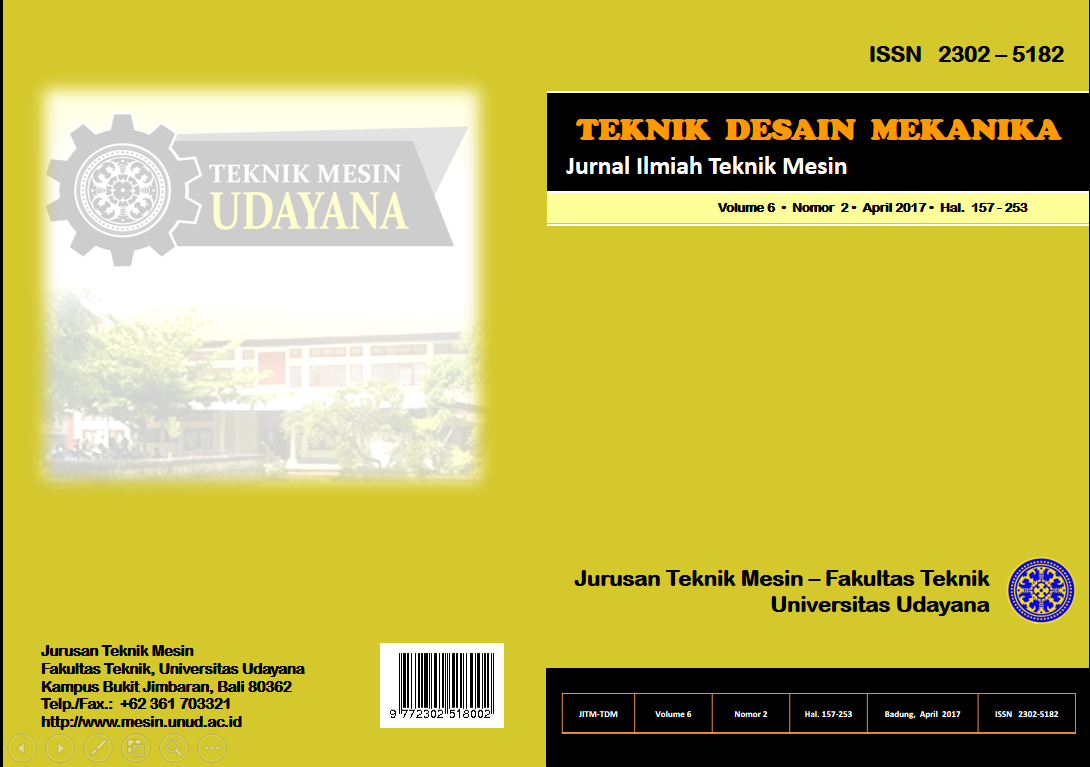Analisis Pembentukan Sudut Semburan Minyak Jelantah pada Ujung Nosel Sederhana
Abstrak
Abstrak
Semakin meningkatnya penggunaan bahan bakar fosil akan berdampak terhadap menipisnya ketersediaan minyak bumi di
alam, oleh karena itu perlu dilakukan penelitian untuk menemukan bahan bakar alternatif. Salah satu bahan bakar alternatif
adalah minyak jelantah karena merupakan limbah dan ketersediaannya yang berlimpah. Parameter yang harus diperhatikan
bila minyak jelantah digunakan sebagai bahan bakar adalah sudut semburan.Tujuan dari penelitian ini adalah untuk
mengetahui karakteristik semburan dari minyak jelantah. Secara teknis minyak jelantah tidak akan teratomisasi karena
viskositasnya yang sangat tinggi. Untuk menurunkan viskositas tersebut maka dilakukan pemanasan awal pada pipa
tembaga yang akan dialiri oleh minyak jelantah. Temperatur pemanasan awal divariasikan pada 350°C, 360°C, 370°C,
380°C dan 390°C dengan tekanan bahan bakar minyak jelantah pada tekanan 3 bar, 4 bar dan 5 bar serta diameter lubang
nosel sebesar 0,5 mm dijaga konstan. Peningkatan temperatur pemanasan awal dan tekanan menyebabkan terjadi
peningkatan sudut semburan minyak jelantah. Jika dibandingkan dengan minyak tanah tanpa pemanasan awal sudut
semburan minyak tanah lebih besar 3.82° daripada minyak jelantah pada temperatur 350°C tekanan 3 bar dan menjadi
1.62° ketika temperatur pemanasan awal minyak jelantah ditingkatkan menjadi 390°C. Penurunan viskositas terjadi dari 75
cP sampai 8 cP pada temperatur 27°C hingga temperatur minyak 100°C. Penurunan nilai viskositas tersebut berpengaruh
terhadap sudut semburan yang dihasilkan pada ujung nosel.
Kata kunci: minyak jelantah, pemanasan awal, sudut semburan.
Abstract
The increasing use of fossil fuel would have an impact on the availability of petroleum depletion in nature, therefore, it is
necessary to do some research to find alternative fuels. One of the alternative fuel is used waste cooking oil(WCO) because it
is a waste and its availability is very abundant. The parameter that must be considered when using the cooking oil as fuel is
the spray angle.The purpose of this study was to determine the characteristics of spray of WCO. Technically, WCO will not
be atomized because the viscosity is very high. To reduce the viscosity, then performed preheating of the copper pipe that
would powered by WCO. The preheat temperatures was varied at 350°C, 360°C, 370°C, 380°C and 390°C with the fuel
pressures of WCO at the pressures of 3 bar, 4 bar and 5 bar and the nozzle orifice diameter of 0.5 mm was kept constant.
The increasing of the preheat temperatures and pressures causes an increase in the spray angle of WCO. In comparison with
kerosene without preheating, spray angle for kerosene is 3.82° greater than WCO at the temperature of 350°C and the
pressure of 3 bar becomes 1.62° when the preheat temperature of WCO increased to 390°C. The decrease of viscosity
occurred from 75 cP to 8 cP at 27°C up to 100°C of the WCO temperature. The decrease of viscosity value affect the spray
angle produced at the nozzle tip.
Keywords: waste cooking oil, preheating, spray angle.


